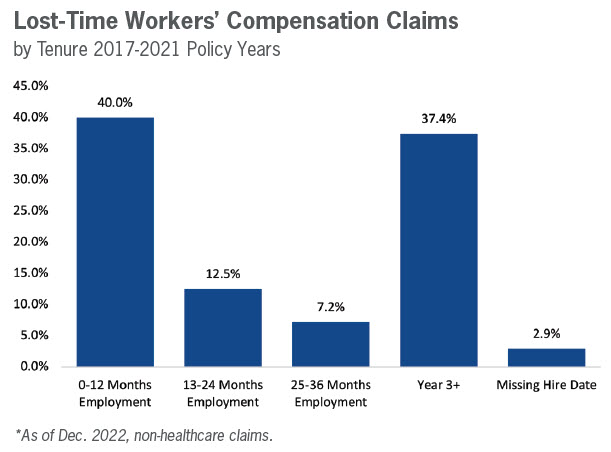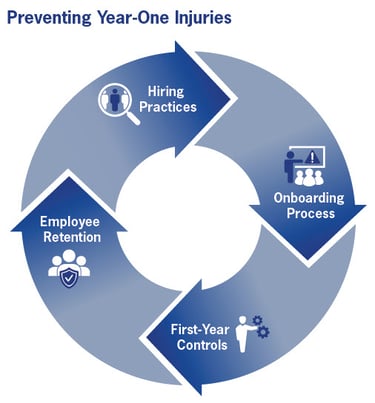
Employers are facing unique challenges in recruiting, hiring, and onboarding new employees. Today, organizations see even greater competition for labor due to more workers seeking new opportunities and people leaving the workforce. From a safety standpoint, a potential increase in accidents and injuries in the first year of employment causes concern.
In PMA’s study of insurance clients from 2017 to 2021 (data valued as of December 2022), approximately 40% of non-healthcare lost-time workers’ compensation claims occur in the first year of employment – a trend that has been increasing since 2017. For healthcare employers, the rate of workers’ compensation lost-time claims in first-year employment is 30%.

Over half (55%) of lost-time claims (non-healthcare) involving employees with less than one year of employment are strains and slip and fall injuries, a consistent trend across many industry groups.
How can you address these challenges? A loss analysis of your first-year injuries (preferably three years of data) is a great first step to begin understanding the source and type of these injuries. Next, consider forming a team that reviews trends organization-wide so changes can be implemented (enlisting the support of your organization’s leadership where necessary). These two steps will give you a solid foundation to build a program to address first-year injuries.
The Four Steps of Organizational Influence — First-Year Injuries
Hiring Practices
Start with examining your hiring practices, ensuring that safety plays a role in hiring the right candidates. Consider these steps:
- Share a written message from your organization’s leader about the importance of safety and the need for all employees to follow safety and occupational health policies.
- Provide a copy of the written job description with a brief explanation of the physical demands and safety procedures tied to the job.
- Have a safety director or management level safety committee member participate in the hiring process.
- Provide candidates with the opportunity to observe a current employee performing the job.
- When applicable, verify qualifications tied to safety.
The Onboarding Process
Once a new employee is hired, onboarding is an important step in preventing injuries. Evaluate the following for your safety program:
- Provide a consistent and well-organized orientation that includes time for employees to learn and demonstrate safe work practices.
- Provide coaching and education with a focus on leading loss areas. (If analytics are unavailable, start with strains and slip and fall prevention.)
- Educate new employees on applicable safety policies for their jobs, including personal protective equipment, safe operating procedures for equipment, and other controls to prevent accidents.
- Provide extended coaching and supervisory attention during the first 12 weeks of employment. This is because most workers’ compensation claims occur in the first 12 weeks of employment, so increase your focus on safety during this time frame.
First-Year Controls
To help ensure new employees remain accident free, consider having your supervisors and safety leaders take the following steps:
- Review your safety programs periodically with a supervisor or assigned coach. Revisit if job duties are expanded.

- Observe first-year employees’ work practices to ensure safety procedures and controls are being followed.
- Conduct ongoing safety education sessions to reinforce safety procedures.
- Allot time for new hires to acclimate to the physical and mental rigors of their jobs and acquire the motor skills to perform required tasks safely and efficiently.
Employee Retention
Maintaining a strong safety culture is not only important in preventing workplace accidents and injuries, but may also help to retain employees. Employers are encouraged to:
- Demonstrate a commitment to safety through communication and action by all levels of the organization.
- Communicate progress on important safety practices through team meetings, sharing examples, and success stories.
- Cover key safety metrics, including first-year employment claim statistics, during each leadership meeting.
Reducing first-year injuries requires prioritizing safety throughout the entire organization, starting with senior leadership. One of the lessons of the pandemic is that a strong culture with mission-focused work – along with a robust focus on safety – can help organizations become both great and safe places to work.
If you have any questions or would like additional information, please contact your local PMA Risk Control Consultant or reach out to us at heretohelp@pmagroup.com.
IMPORTANT NOTICE
The information and suggestions presented by PMA Companies in this risk control technical bulletin are for your consideration in your loss prevention efforts. They are not intended to be complete or definitive in identifying all hazards associated with your business, preventing workplace accidents, or complying with any safety related or other laws or regulations. You are encouraged to alter the information and suggestions to fit the specific hazards of your business and to have your legal counsel review all of your plans and company policies. PMA Companies and Old Republic Companies do not provide legal advice and the information and suggestions in this bulletin should not be considered as such.




